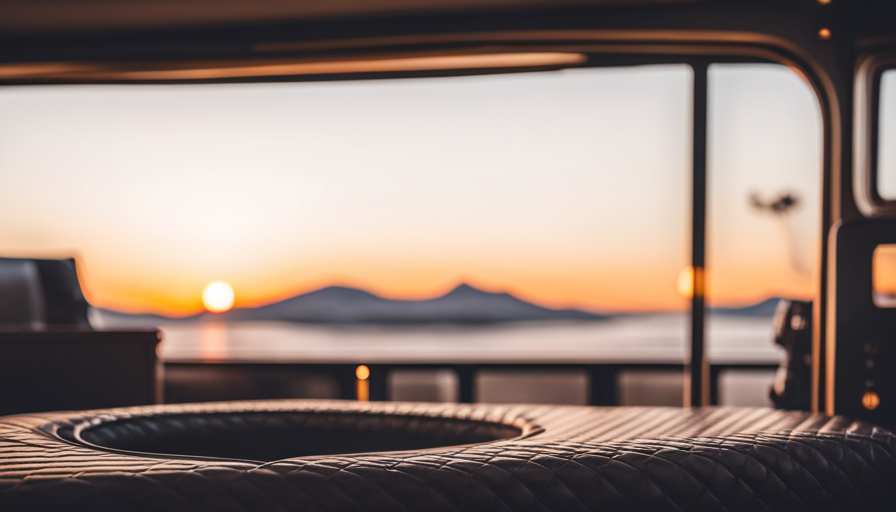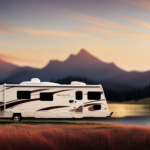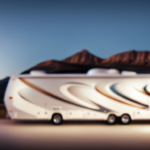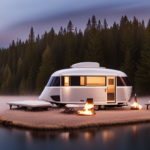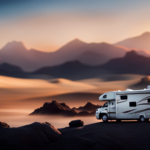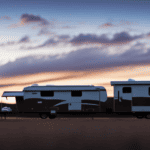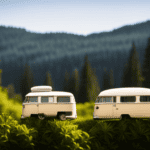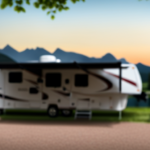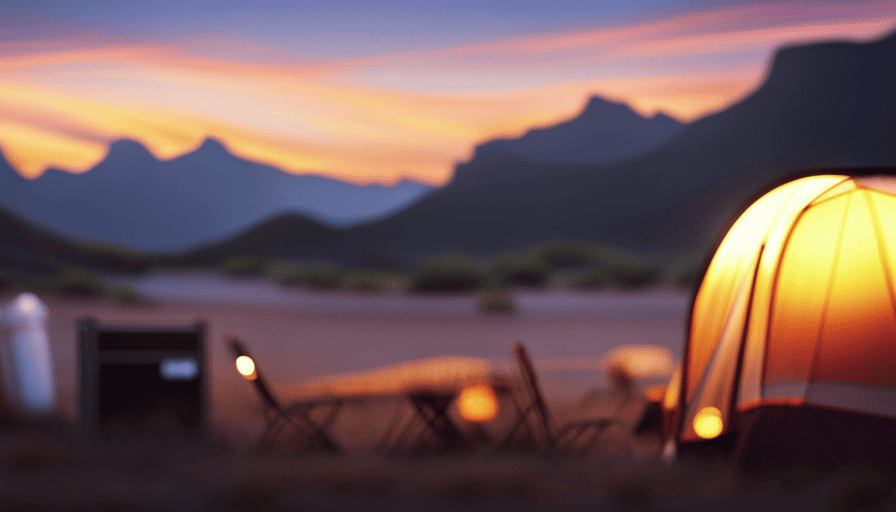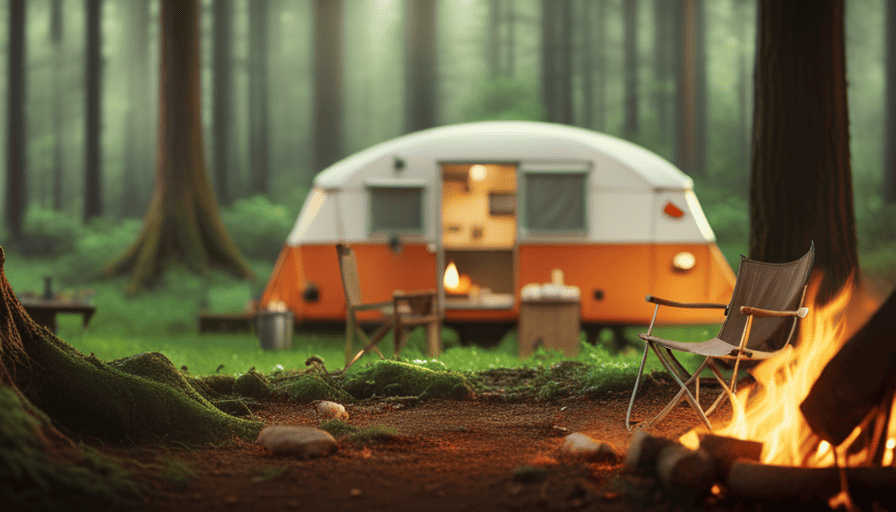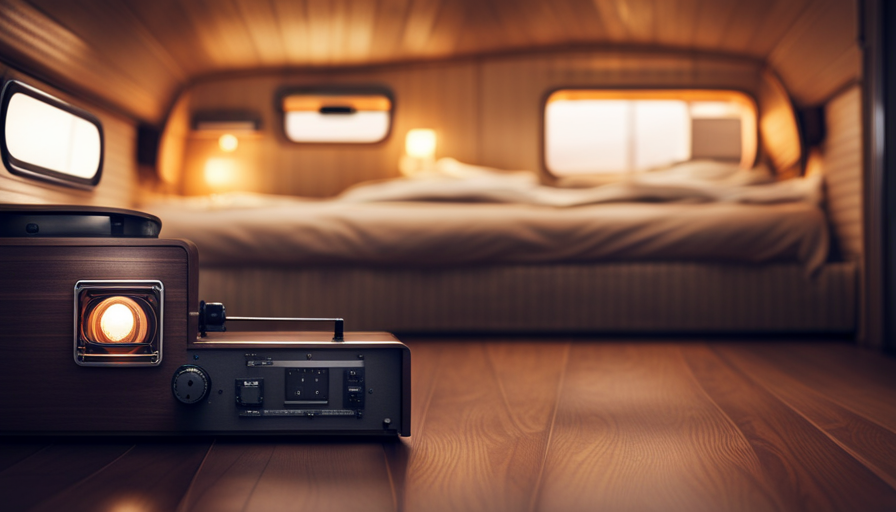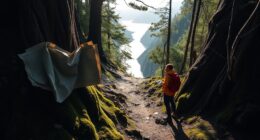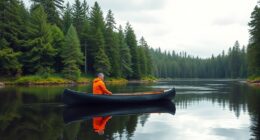Were you aware that the demand for 5th wheel campers has been consistently rising over the last ten years?
These spacious and versatile RVs offer a unique camping experience that is hard to match. With their distinct design and features, 5th wheel campers have become a sought-after choice for many outdoor enthusiasts.
In this article, we will explore what exactly a 5th wheel camper is and why it stands out from other types of RVs. We will discuss the advantages and disadvantages of owning one, as well as provide tips for choosing the right model. Additionally, we will highlight popular brands and models to help you make an informed decision.
Towing and maneuvering a 5th wheel camper can seem intimidating, but fear not! We will share some useful tips to make the process easier. We will also explore accessories and upgrades that can enhance your camping experience.
Whether you’re a seasoned camper or just starting out, this article will provide you with valuable information about 5th wheel campers and help you decide if it’s the right choice for your next adventure.
Key Takeaways
- 5th wheel campers provide a unique and sought-after camping experience with their distinct design and features.
- They offer advantages such as spaciousness, ease of maintenance, and a raised forward section for additional living space.
- 5th wheel campers are known for their top-notch stability, maneuverability, and shorter overall length compared to other RVs.
- Owning a 5th wheel camper provides the freedom to travel to various destinations, enjoy comfort and convenience, and create unforgettable experiences.
Definition and Features of a 5th Wheel Camper
So you’re probably wondering, what exactly is a 5th wheel camper? Well, let me tell you, it’s not your average RV.
A 5th wheel camper is a type of recreational vehicle that is towed by a pickup truck using a fifth wheel hitch. It is called a ‘5th wheel’ because it has a raised forward section that extends over the bed of the truck, creating a unique tow configuration. The raised forward section of the 5th wheel camper provides additional living space and often includes a master bedroom. These campers are popular for their stability and maneuverability, making them a favorite choice for long-term travelers. Many people wonder, “how tall is a camper?” The height of a 5th wheel camper can vary, but most fall within the range of 10-13 feet when fully set up for travel. The raised forward section allows for increased stability and maneuverability while towing, making 5th wheel campers a popular choice for many RV enthusiasts. The average height of 5th wheel campers is typically around 13-14 feet, making them taller than traditional travel trailers. This additional height provides more headroom and interior space, allowing for larger living quarters and amenities within the camper.
One of the benefits of a 5th wheel camper is its spaciousness. Since the raised forward section provides additional living space, these campers often have more room than traditional RVs. This extra space can be used for amenities like larger kitchens, bathrooms, and bedrooms, making it more comfortable for extended trips.
Another advantage is the ease of maintenance. 5th wheel campers are generally easier to maintain compared to other types of RVs. The construction and design allow for better weight distribution, which can result in improved towing stability and reduced wear on the truck’s tires and brakes.
Now, let’s talk about how a 5th wheel camper differs from other RVs.
How a 5th Wheel Camper Differs from Other RVs
When it comes to comparing a 5th wheel camper to other RVs, there are several key points to consider.
First, the towing mechanism sets it apart, as it attaches to a special hitch located in the bed of a pickup truck. This unique setup allows for better maneuverability and stability on the road.
Additionally, the interior space and layout of a 5th wheel camper tend to be more spacious and open, thanks to the raised section that extends over the bed of the truck. This provides a separate living area and bedroom, giving it a more home-like feel.
Lastly, the stability and maneuverability of a 5th wheel camper are top-notch, as the weight distribution over the truck’s rear axle provides better control while driving and backing up.
Towing Mechanism
To fully understand how a 5th wheel camper connects to your truck, let me explain the intricate mechanics of its towing mechanism.
Unlike other RVs, a 5th wheel camper uses a unique hitch installation that requires a specialized hitch mounted in the bed of your truck. This hitch has a pivoting plate that allows the camper to turn and maneuver with ease.
Additionally, the weight distribution is crucial in ensuring a safe and stable towing experience. The hitch is designed to distribute the weight of the camper evenly between the truck’s front and rear axles, reducing the strain on the rear axle and improving overall stability on the road.
This towing mechanism provides a smooth and controlled towing experience, making it easier than ever to tow a 5th wheel camper.
Now, let’s explore the interior space and layout of these campers.
Interior Space and Layout
Now, let’s take a peek inside and discover the amazing interior space and layout of these incredible homes on wheels. The interior of a 5th wheel camper is designed with maximizing space in mind. Here are some key features that make it so impressive:
-
Storage options: These campers are equipped with clever storage solutions to make the most of every nook and cranny. From overhead cabinets to under-bed compartments, there’s ample space for all your belongings.
-
Well-thought-out layout: The layout of a 5th wheel camper is carefully planned to ensure functionality and comfort. The living area is spacious, with comfortable seating and room for entertaining. The kitchen’s equipped with all the essential appliances and plenty of counter space for meal preparation.
-
Bedroom privacy: Unlike other types of campers, 5th wheels often have a separate bedroom area, providing privacy and a cozy retreat.
With its smart storage options and well-designed layout, a 5th wheel camper offers a comfortable and enjoyable living space on the go.
Now, let’s delve into the next section and explore the stability and maneuverability of these remarkable campers.
Stability and Maneuverability
Built with precision and engineered for stability, these remarkable homes on wheels effortlessly navigate the roads with exceptional maneuverability. The stability of a 5th wheel camper is a result of its design, which places the hitching mechanism in the bed of a pickup truck. This configuration distributes the weight evenly between the truck and the camper, creating a stable and balanced ride.
Despite their spacious interiors, 5th wheel campers are surprisingly maneuverable due to their shorter overall length compared to other RVs. This allows for easier navigation through tight spaces and sharp turns. Additionally, the weight of a 5th wheel camper is concentrated over the truck’s rear axle, resulting in improved handling and reduced sway.
These features make the 5th wheel camper an ideal choice for those seeking stability and maneuverability in their travels. As we move on to discuss the advantages of owning a 5th wheel camper, it’s important to consider the freedom and comfort they provide.
Advantages of Owning a 5th Wheel Camper
One of the best things about owning a 5th wheel camper is how it gives us the freedom to travel and explore without sacrificing comfort and convenience. The advantages of owning a 5th wheel camper are numerous, starting with the cost comparison. When compared to traditional RVs or motorhomes, 5th wheel campers tend to be more affordable. They’re often cheaper to purchase and maintain, making them a great option for those looking to hit the road on a budget.
In addition to the cost savings, 5th wheel campers offer more living space compared to other types of campers. With their unique design, they provide additional square footage and often come equipped with multiple slide-outs, allowing for extra room to relax and enjoy your time on the road. This extra space makes them ideal for families or those who enjoy entertaining guests during their travels.
Furthermore, 5th wheel campers provide excellent stability and maneuverability when towing. Their unique hitching system allows for better weight distribution, making them easier to tow and control on the road. This stability gives us peace of mind while driving and allows us to navigate tight spaces and winding roads with ease.
As we explore the advantages of owning a 5th wheel camper, it’s important to mention that there are also some disadvantages to consider. However, these drawbacks shouldn’t overshadow the many benefits that come with owning one.
Disadvantages of Owning a 5th Wheel Camper
While there are many advantages to owning a 5th wheel camper, it’s important to consider the potential drawbacks as well.
One notable disadvantage is the cost. 5th wheel campers tend to be more expensive than other types of RVs, and they also require a specialized hitch that can add to the overall cost.
Additionally, maintenance can be more time-consuming and expensive for 5th wheel campers. The larger size and weight of these campers can lead to more wear and tear on the tires, brakes, and suspension, requiring more frequent maintenance and repairs.
Another disadvantage is the size restrictions that come with owning a 5th wheel camper. These campers are generally larger and taller than other RVs, making it more difficult to navigate tight spaces or park in certain campgrounds that have size limitations.
Despite these disadvantages, choosing the right 5th wheel camper can still be a great option for those who prioritize spaciousness and amenities.
Choosing the Right 5th Wheel Camper
When selecting the perfect 5th wheel for your needs, it’s crucial to consider factors such as size, amenities, and maneuverability.
One important consideration is the towing capacity of your vehicle. Make sure to check your vehicle’s towing capacity before purchasing a 5th wheel camper to ensure that it’s compatible.
Additionally, consider your budget when choosing a 5th wheel camper. Determine how much you’re willing to spend and look for options that fit within your price range.
Size is another important factor to consider. Think about how many people will be using the camper and how much living space you’ll need. Consider the number of bedrooms, bathrooms, and living areas that will accommodate your needs.
Amenities are also crucial to consider when choosing a 5th wheel camper. Think about the features that are important to you and your family. Do you need a full kitchen? How about a spacious bathroom? Make a list of must-have amenities and prioritize them when searching for a camper.
Consider the maneuverability of the camper. Will you be traveling to tight campsites or navigating narrow roads? Look for a 5th wheel camper that’s easy to maneuver and can handle different terrains.
When selecting the perfect 5th wheel camper, it’s important to take into account factors such as towing capacity and budget considerations. Now, let’s move on to maintenance and care tips for a 5th wheel camper.
Maintenance and Care Tips for a 5th Wheel Camper
To ensure your 5th wheel stays in top condition, it’s important to properly maintain and care for it. Regular RV maintenance can help prevent breakdowns and extend the lifespan of your camper. Here are some maintenance and care tips to keep your 5th wheel camper in great shape:
-
Regularly inspect the exterior of your camper for any signs of damage, such as cracks or leaks. Repairing these issues promptly can prevent further damage and costly repairs down the line.
-
Clean your camper regularly, both inside and out. This includes washing the exterior, cleaning the interior, and vacuuming the carpets. Keeping your camper clean will not only make it more enjoyable to use, but it’ll also help prevent the buildup of dirt and grime.
-
Check and maintain your camper’s tires. This includes inspecting the tread, checking the air pressure, and rotating the tires as recommended by the manufacturer. Proper tire maintenance is crucial for safe and smooth travels.
By following these maintenance tips and caring for your 5th wheel camper, you can ensure that it’ll provide you with many years of enjoyment.
Now, let’s dive into the world of popular 5th wheel camper brands and models.
Popular 5th Wheel Camper Brands and Models
Now let’s explore the world of popular 5th wheel camper brands and models, where you’ll discover a wide range of options to suit your travel needs.
When it comes to popular 5th wheel camper brands, there are a few that stand out from the rest. One of the top brands is Forest River, known for their high-quality construction and innovative designs. Their Sierra and Wildcat models are especially popular among RV enthusiasts.
Another well-regarded brand is Keystone, with their Montana and Cougar models consistently ranking among the best in the industry.
If you’re looking for luxury, DRV Luxury Suites offers the Mobile Suites and Elite Suites lines, known for their luxurious interiors and top-of-the-line features.
Grand Design is also a popular choice, with their Reflection and Solitude models offering spacious layouts and modern amenities.
Lastly, Jayco is a trusted brand that offers a variety of 5th wheel campers, including their popular Eagle and North Point models.
With such a wide selection of popular brands and models, you’re sure to find the perfect 5th wheel camper for your next adventure.
Now, let’s transition into the next section and learn some tips for towing and maneuvering a 5th wheel camper.
Tips for Towing and Maneuvering a 5th Wheel Camper
Navigating a 5th wheel can be challenging, but did you know that 95% of accidents involving RVs are due to driver error? That’s why it’s crucial to have the right towing tips and maneuvering techniques under your belt.
First and foremost, make sure to always double-check your hitch connections before hitting the road. Securely fasten the hitch and ensure that the safety chains are properly attached.
When it comes to maneuvering, take it slow and steady. Give yourself plenty of room when turning corners and be mindful of the length and height of your camper. Practice backing up in an open space before attempting it in a crowded campground.
It’s also important to know the weight limits of your vehicle and the camper to avoid overloading. In windy conditions, reduce your speed and be prepared for gusts that can affect the stability of your camper.
By following these towing tips and maneuvering techniques, you’ll be well-prepared to handle your 5th wheel camper with confidence.
Transitioning into the next section about accessories and upgrades for a 5th wheel camper, it’s important to consider how these can enhance your overall towing and maneuvering experience.
Accessories and Upgrades for a 5th Wheel Camper
When it comes to accessories and upgrades for a 5th wheel camper, there are a few key points to consider.
First, upgraded hitch systems can greatly improve towing stability and ease of maneuvering.
Second, installing RV solar panels can provide a sustainable and eco-friendly power source while on the road.
And finally, interior decor and comfort enhancements can make your camper feel like a home away from home.
These upgrades and accessories can greatly enhance your camping experience and make your 5th wheel camper even more enjoyable to use.
Upgraded Hitch Systems
Upgrade your hitch system and experience a newfound sense of security and stability on your adventures with your 5th wheel camper. Upgraded hitch systems are designed to provide better weight distribution and control, ensuring a smooth and safe towing experience.
These advanced systems use innovative technologies to distribute the weight of your camper evenly across all axles, reducing the risk of trailer sway and improving overall handling. With an upgraded hitch system, you can confidently navigate through winding roads or challenging terrains, knowing that your camper is securely attached to your vehicle.
Next, we’ll explore another essential upgrade for your 5th wheel camper: RV solar panels. These panels offer a sustainable and efficient way to power your camper, allowing you to enjoy the outdoors without worrying about running out of electricity.
RV Solar Panels
With RV solar panels, you’ll have the power of the sun on your side, allowing you to soak up the energy and adventure without worrying about running out of electricity.
RV solar installation is a popular upgrade among campers because it offers numerous benefits. First and foremost, it provides a renewable and clean source of energy, reducing your reliance on fossil fuels and minimizing your carbon footprint. Additionally, solar power in RVs allows for greater independence and flexibility, as you can camp in remote locations without access to traditional power sources. You can also save money by relying less on campsite hookups or generators.
The installation process is relatively simple, and once in place, the solar panels silently convert sunlight into electricity. So, with RV solar panels, you can enjoy the freedom to explore while keeping your batteries charged.
Now, let’s talk about interior decor and comfort enhancements.
Interior Decor and Comfort Enhancements
Imagine stepping inside your RV and being greeted by a cozy and inviting interior that feels like a home away from home. When it comes to the interior decor and comfort enhancements of a 5th wheel camper, there are endless options to choose from.
From plush upholstery options to luxurious materials, you can customize your RV to reflect your personal style and preferences. Additionally, incorporating smart home technology into your 5th wheel camper can greatly enhance your comfort and convenience.
Imagine controlling the temperature, lighting, and entertainment system with just a touch of a button. These advancements make your RV experience even more enjoyable and hassle-free.
As we conclude our exploration of 5th wheel campers, we will reflect on the many features and possibilities they offer for creating a comfortable and luxurious home on wheels.
Conclusion and Final Thoughts on 5th Wheel Campers
Overall, when it comes to 5th wheel campers, it’s clear that they offer a level of comfort and convenience that is hard to match. These campers provide the perfect blend of mobility and luxury, making them an ideal choice for those who love to travel and explore the great outdoors.
Here are some final thoughts on 5th wheel campers:
-
Upgrades and modifications: One of the great things about 5th wheel campers is the ability to customize and upgrade them to suit your needs. Whether it’s adding solar panels for off-grid camping or installing a slide-out for extra living space, there are endless possibilities for enhancing the comfort and functionality of your camper.
-
Cost and budgeting: While 5th wheel campers can be a significant investment, they can also offer long-term savings compared to traditional vacations. With a camper, you have the freedom to cook your own meals and avoid expensive hotel stays. Additionally, by carefully budgeting for maintenance and repairs, you can ensure that your camper stays in top condition without breaking the bank.
-
Versatility: 5th wheel campers are incredibly versatile, allowing you to travel to various destinations without sacrificing comfort. Whether you’re exploring national parks, camping by the beach, or attending a music festival, these campers provide all the amenities you need for a comfortable and enjoyable trip.
-
Community: Owning a 5th wheel camper opens up a whole new world of community and camaraderie. Campgrounds and RV parks often have a tight-knit community of fellow campers, creating opportunities for socializing, making new friends, and sharing experiences.
-
Freedom: Perhaps the greatest advantage of owning a 5th wheel camper is the freedom it provides. You have the freedom to go wherever you want, whenever you want, without the hassle of booking accommodations or worrying about availability. The open road is yours to explore, and the possibilities are endless.
In conclusion, 5th wheel campers offer a level of comfort, customization, and freedom that is hard to beat. Whether you’re a seasoned traveler or a first-time camper, investing in a 5th wheel camper can open up a world of adventure and unforgettable experiences. So, pack your bags, hit the road, and start creating memories that will last a lifetime.
Frequently Asked Questions
Can a 5th wheel camper be towed by a regular pickup truck?
Yes, a 5th wheel camper can be towed by a regular pickup truck. As long as the truck has the necessary towing capacity and is equipped with a compatible trailer hitch. The towing capacity of the pickup truck should be able to handle the weight of the 5th wheel camper, and the hitch should be specifically designed for 5th wheel trailers. This allows for a secure and efficient towing experience, providing both safety and convenience.
Are there any weight restrictions for towing a 5th wheel camper?
When it comes to towing a 5th wheel camper, there are indeed weight restrictions that need to be considered. The towing capacity of a regular pickup truck plays a crucial role in determining if it can handle the weight of a 5th wheel camper.
It’s important to check the truck’s towing capacity before hitching up, as exceeding the weight limit can lead to unsafe driving conditions. Always prioritize safety when towing a 5th wheel camper.
How much does a 5th wheel camper typically cost?
When it comes to the cost of a 5th wheel camper, the price can vary depending on several factors. The cost range for a 5th wheel camper can start from around $20,000 and go up to $100,000 or more.
Factors such as the size, brand, features, and overall condition of the camper can all affect the price. It’s important to consider these factors when budgeting for your dream 5th wheel camper.
Are there any specific licensing or registration requirements for owning a 5th wheel camper?
When it comes to owning a 5th wheel camper, there are specific licensing and registration requirements to keep in mind. These requirements vary depending on the state you reside in. Typically, a special driver’s license or endorsement is needed to operate a 5th wheel camper, as it’s larger and heavier than a traditional vehicle.
Additionally, you’ll need to register your camper with the appropriate authorities to ensure compliance with local regulations.
What are some common maintenance issues to look out for with a 5th wheel camper?
When it comes to common maintenance issues with a 5th wheel camper, there are a few things to keep an eye on.
Regularly inspecting the tires for wear and proper inflation is crucial.
Additionally, checking the roof for any leaks or damage is important to prevent water damage.
Another troubleshooting tip is to ensure all electrical connections are secure and functioning properly.
By staying on top of these maintenance tasks, you can enjoy a smooth and hassle-free camping experience.
What Makes a Fifth Wheel Camper the Best Choice?
When it comes to camping, the best fifth wheel camper offers a combination of comfort, convenience, and versatility. With ample living space, towing stability, and various amenities, a fifth wheel camper ensures a memorable experience on the road. Whether it’s spacious interiors, slide-out features, or exceptional storage capacity, the best fifth wheel camper caters to all your adventure needs.
Conclusion
In conclusion, owning a 5th wheel camper is a fantastic choice for those who enjoy traveling and exploring the great outdoors. With its unique design and spacious interior, it offers a comfortable and convenient living space on the road.
While some may argue that towing and maneuvering a 5th wheel camper can be challenging, with the right knowledge and practice, it becomes a seamless experience. So don’t let the fear of towing hold you back from experiencing the joys of owning a 5th wheel camper and embarking on unforgettable adventures.

